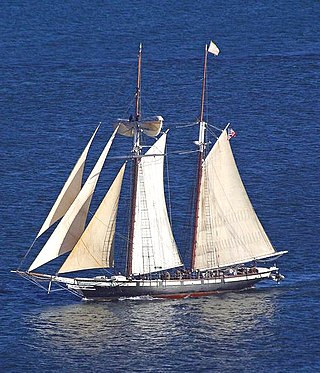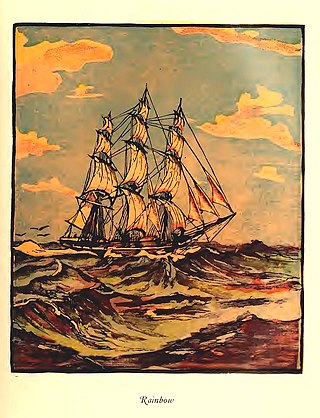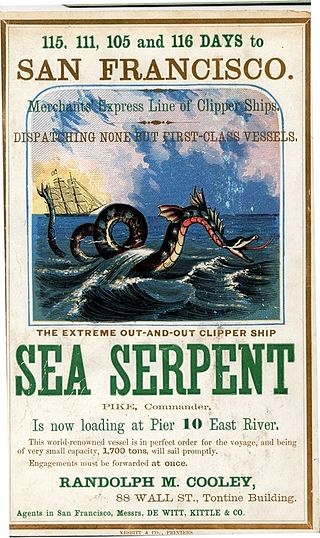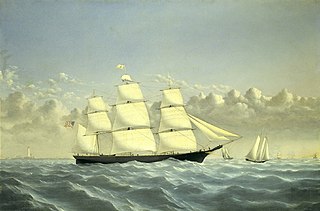
A clipper was a type of mid-19th-century merchant sailing vessel, designed for speed. The term was also retrospectively applied to the Baltimore clipper, which originated in the late 18th century.

Flying Cloud was a clipper ship that set the world's sailing record for the fastest passage between New York and San Francisco, 89 days 8 hours. The ship held this record for over 130 years, from 1854 to 1989.

Donald McKay was a British North America-born American designer and builder of sailing ships, famed for his record-setting extreme clippers.

A Baltimore clipper is a fast sailing ship historically built on the mid-Atlantic seaboard of the United States, especially at the port of Baltimore, Maryland. An early form of clipper, the name is most commonly applied to two-masted schooners and brigantines. These vessels may also be referred to as Baltimore Flyers.

Isaac McKim was a U.S. Representative from Maryland, nephew of Alexander McKim. McKim's five terms as a Congressman saw him change parties three times.

Sea Witch was an American clipper ship designed by naval architect John W. Griffiths for the China trading firm of Howland & Aspinwall. She was launched at Smith & Dimon in Manhattan on December 8, 1846.

Stag Hound was launched on December 7, 1850, in East Boston, Massachusetts. Designed by shipbuilder Donald McKay for the California trade, she was briefly the largest merchant ship in the world. She was in active service from 1851 until her total loss in 1861.

Robert H. Waterman, known as Bully Waterman or Bully Bob Waterman, was an American merchant sea captain. He set three sailing speed records; his time of 74 days from Hong Kong to New York City has never been bettered in a sail-powered vessel. He was reputed as a martinet, and was once convicted of assault against a crewman in a controversial California criminal case.

Rainbow, launched in New York in 1845 to sail in the China trade for the firm Howland & Aspinwall, was a clipper, a type of sailing vessel designed to sacrifice cargo capacity for speed.

Surprise was a California clipper built in East Boston in 1850. It initially rounded Cape Horn to California, but the vessel's owners, A. A. Low & Brother, soon found that the vessel performed well in Far Eastern waters. From that point onward the vessel spent much of her working life in the China trade, although the vessel also made three trips from the East Coast of the United States to California.

Carrier Dove was an 1855 medium clipper. She was one of two well-known clippers launched in Baltimore that year, the other being Mary Whitridge.

Sea Serpent was an 1850 extreme clipper that sailed in the San Francisco trade, the China trade, and the transatlantic lumber trade. She was one of the longest lived clippers, with a service life of 36 years and 5 months.
Harriet Hoxie was an 1851 clipper in the California trade. She was known for carrying cargoes of whale oil from Honolulu, and for importing the first Brown Leghorn chickens to the United States.

The Memnon was the first clipper ship to arrive in San Francisco after the Gold Rush, and the only clipper to arrive in San Francisco before 1850. Built in 1848, she made record passages to San Francisco and to China, and sailed in the first clipper race around Cape Horn.
An extreme clipper was a clipper designed to sacrifice cargo capacity for speed. They had a bow lengthened above the water, a drawing out and sharpening of the forward body, and the greatest breadth further aft. In the United States, extreme clippers were built in the period 1845 to 1855. British-built extreme clippers include vessels built over the period 1854 to 1870.

Golden West was an 1852 extreme clipper built by Paul Curtis. The ship had a very active career in the California trade, the guano trade, the coolie trade, the Far East, and Australia. She made a record passage between Japan and San Francisco in 1856.

Mary Ann Brown Patten or Patton was the first female commander of an American merchant vessel. She was the wife of Joshua Patten, captain of the merchant clipper ship Neptune’s Car. The ship was bound around Cape Horn from New York towards San Francisco when Joshua Patten collapsed from fatigue in 1856. His wife took command for 56 days, faced down a mutiny, and successfully managed to navigate the clipper ship into San Francisco. At the time of docking, she was 19 years old and eight months pregnant with her only child.

Helena was a China packet built by William H. Webb in 1841. Helena is often called a "pre-clipper" or "early clipper ship", type of the fast ships that were a precursor to the fast clippers that dominated the China trade routes for years to follow.
John Alexander Robb, was a 19th-century prominent shipbuilder at Fell's Point, Baltimore. He had his own shipyard, which became noted for fast sailing Baltimore Clippers. He was an apprenticeship under shipbuilder Henry Eckford. Abolitionist Frederick Douglass, as a young man, worked at the John A. Robb shipyard as a caulker for several years. Robb built the steamship Pulaski, that was lost off Cape Lookout in the 1838 Steamship Pulaski disaster. Robb died in Baltimore, Maryland, in 1867.



















